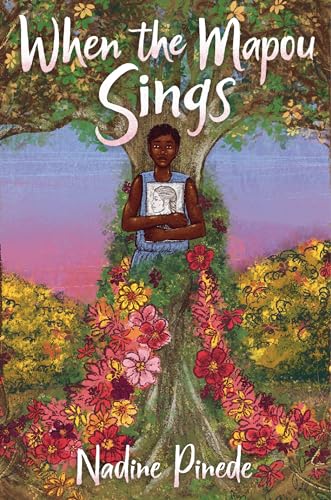In exquisite yet accessible poetry, Nadine Pinede tells the story of Lucille’s coming of age in “When the Mapou Sings” (Candlewick 2024). The story is set in 1935 Haiti, when the nation is just emerging from the USA occupation that has lasted from 1915 to 1934. Haiti was first inhabited by the Taino people, then was occupied by Spain in 1496. The eastern half of the island of Hispaniola was ceded to the French in 1697. In 1791 African-born slaves and their descendants revolted against the French and in 1804, Haiti became an independent country ruled by itrs own citizens. But Haiti’s problems weren’t over.
1935 Haiti, when the nation is just emerging from the USA occupation that has lasted from 1915 to 1934. Haiti was first inhabited by the Taino people, then was occupied by Spain in 1496. The eastern half of the island of Hispaniola was ceded to the French in 1697. In 1791 African-born slaves and their descendants revolted against the French and in 1804, Haiti became an independent country ruled by itrs own citizens. But Haiti’s problems weren’t over.
Teenaged Lucille claims traces of all these cultures mentioned above.
On Lucille’s first day at the Mission School, she befriends beautiful Fifina, who is “drawing a bird/ in red earth with a twig/ from Mapou.” Mapou is the kapok tree, and Lucile is delighted to have befriended Fifina. “We walked back to the classroom/ inside me/ a sunrise.” The two girls soon make plans to start their own school: “We’ll teach girls how to carve, sew, draw, climb trees./ We’ll teach girls the songs of trees, flowers, birds, butterflies, the sun, moon, mountains, clouds.”
The mapou tree sings to Lucille, whose mother has died. The girl says, “A mother whose face/ I can’t remember/ and whose songs/ I can’t forget.
Their teacher, Sister Gilberte, shows the girls a map of her home—Belgium. She became a nun when her fiancé was killed in World War I. The nun says, “The trouble with love/ is the cracks in your heart/ never mend.”
The girls are the same age, but Fifina has matured into a woman sooner than Lucille and one day she disappears. In a dream the mapou tree tells Lucille to go to the village section chief. Something horrible has happened to Fifina at the section chief’s hand, and whereas Lucille doesn’t know exactly what happened, she knows the chief is corrupt and tells him so. This puts her in grave danger.
Lucille must leave her home and village. She’s hired as a servant for a wealthy Port-au-Prince woman. Foolishly she falls in love with the woman’s son. The educated young man helps raise Lucille’s consciousness concerning the corruption occurring in Haiti. Having become an activist in the reform movement, Lucille must move again to save herself. All the time she searches for Fifina.
Now she works for an America scholar who is doing fieldwork and studying Haitian voodoo and writing a novel. This turns out to be Zora Neal Hurston who is writing Their Eyes Were Watching God. Because of Hurston’s research and their activism, the two women find themselves fighting for their lives and the country of Haiti, all the time Lucille searches for her childhood friend and the man she loves.
This story, set in a time and place of important but little-known history, is not only poetry, but it’s a page-turner.
Patricia Hruby Powell is the author of the award-winning books: Josephine; Lift As You Climb; Loving vs Virginia; and Struttin’ With Some Barbecue all signed and for sale at Jane Addams bookstore. Her forthcoming books are about women’s suffrage, Martha Graham, and Ella Fitzgerald, as well as waterfowl. talesforallages.com
Leave a Reply